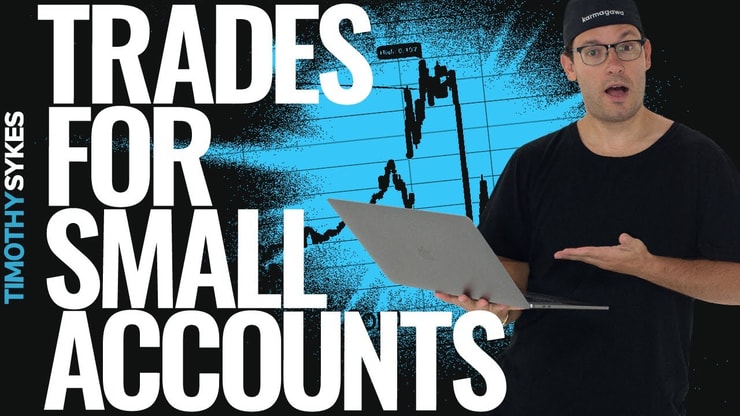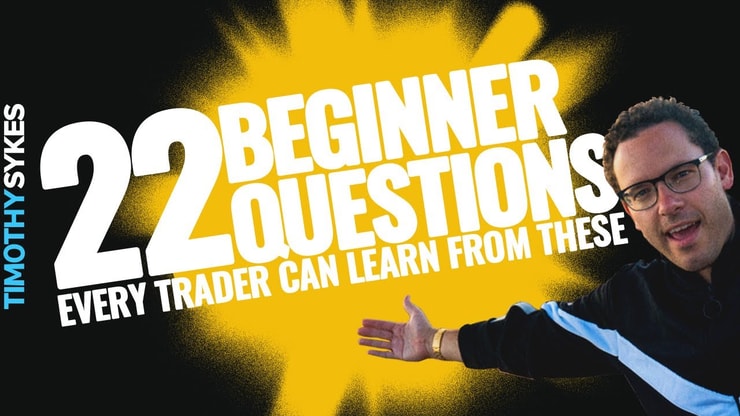Are you interested in stock trading for beginners? Curious about what strategies top traders use?
Trading stocks doesn’t have to be complicated … and it definitely doesn’t require an advanced math or physics degree. But it does require a lot of research, studying, and hard work to understand what makes the market move.
So many new traders fail because they don’t take the time to learn the basics.
You’re already ahead of the curve by finding this article. It tells me that you want to educate yourself. You want to do better than the many new traders who blow up their accounts.
By learning all you can about trading before you start putting your money on the line, you’re taking a big step toward smart trading.
What is day trading? Want to become an intelligent trader, but not sure how to get started trading stocks? In this post, I’ll go over how to buy stocks for beginners and share my favorite stock trading platform.
I’ll also share why I don’t think investing is the best strategy for beginners … Intrigued? Read on.
But first…
Table of Contents
- 1 What’s Stock Trading?
- 2 Risks of Stock Trading
- 3 Stock Trading for Beginners: How Does Stock Trading Work?
- 4 Types of Stock Trading
- 5 Stock Trading for Beginners in 6 Steps
- 5.1 Stock Trading for Beginners Tip #1: Open a Trading Account
- 5.2 Stock Trading for Beginners Tip #2: Technical and Fundamental Analysis
- 5.3 Stock Trading for Beginners Tip #3: Practice Before You Start Trading
- 5.4 Stock Trading for Beginners Tip #4: Learn Stock Market Terms
- 5.5 Stock Trading for Beginners Tip #5: Choose the Best Laptop for Your Stock Trading Needs
- 5.6 Stock Trading for Beginners Tip #6: Keep Learning
- 6 How Do You Pick Stocks to Trade? 3 Stock Trading Strategies for Beginners
- 7 What’s the Best Stock Trading Website for Beginners?
- 8 Are Stocks a Good Investment for Beginners?
- 9 Trading Challenge
- 10 Frequently Asked Questions About Stock Trading for Beginners
- 11 Bottom Line: Are You Ready to Start Stock Trading?
What’s Stock Trading?

Since this is stock trading for beginners, let’s start at the very beginning. What’s stock trading, anyway?
When many people think of the stock market, they imagine something that’s not quite trading. Like Warren Buffett buying stock in a massive company and sitting on it for years, collecting dividends as the company grows. That’s NOT trading — it’s investing.
Day trading is a more active strategy. Traders buy and sell as a stock’s price fluctuates.
Nearly every stock fluctuates in price every single day. If you know what you’re doing, you can potentially learn to ride the momentum of these price movements.Personally, I find trading way more exciting than long-term investing … and for me, it’s been the best way to grow a small account in a short period of time.*
What’s Penny Stock Trading?
Penny stock trading refers specifically to trading low-priced stocks. They don’t have to be literally pennies — a penny stock is actually any stock below $5 per share.
These are typically small companies. They might have just a few products, or they might be in an emerging industry.
This is important: Many of these companies will eventually fail. Unlike a large-cap company, you won’t invest your money for years and years, hoping for a return.
Penny stock trading is not investing. It’s a short-term strategy that allows you to potentially profit from the volatility of fast-moving, low-priced stocks.
I think it also has greater potential to grow your account quickly, as opposed to buying slow-moving, large-cap stocks. That’s if you come educated and prepared.
When you trade large-cap stocks like Amazon, Netflix, and Microsoft, you’re competing with the world’s biggest, smartest, and richest traders, banks, and hedge funds. I’m not interested in that — are you?
In the penny stock trading world, it’s not uncommon to see a stock move 20%, 100%, or more in a week, or even within a day. If you can consistently catch just a part of some of these moves, it’s not hard to see how it could grow your account quickly.
If you’re willing to learn the right strategy, develop your discipline, and watch the right stocks, penny stocks could be a great niche for you … just ask any of my top students.*
(*Please note that these kinds of trading results are not typical. Most traders lose money. It takes years of dedication, hard work, and discipline to learn how to trade, and individual results will vary. Trading is inherently risky. Before making any trades, remember to do your due diligence and never risk more than you can afford to lose.)
Risks of Stock Trading

The biggest risk of stock trading? Well, you could lose money. In some cases — if you short sell, for instance — it’s even possible to lose more money than you put into the market in the first place.
Risk is a big part of stock trading, and it’s always going to be. You can’t change that.
With risk comes reward: It’s the volatility of stocks that can make them spike in price and potentially deliver massive profits.
But you don’t need to love risk to be a trader. In fact, I hate it!
The risk inherent in the market should serve as motivation to avoid losing money … The best way to do that is by thoroughly researching and planning out your trades. Base your trades on factual findings rather than gut feelings.
Stock Trading for Beginners: How Does Stock Trading Work?
Trading stocks really isn’t that complicated. All you really need is a brokerage account, an internet connection, and a computer. From there, you’ve got so many different potential directions.
Types of Stock Trading

There are a ton of different approaches to stock trading. Some common ones?
Day Trading: This is trading where you open and close a position within the same trading day. Yep: you buy and sell the stock between the market hours of 9:30 a.m. and 4 p.m. Eastern.
Position Trading: Long-term trading — you invest in a company for a longer period … months or even years.
Scalping: Super short-term trading where you try to profit off of micro-fluctuations. You might hold a position for mere minutes. This type of trading relies on volume.
Swing Trading: A moderate approach where your positions are less based on a specific time period and more on maximizing the price “swings” of a trend. A position might last anywhere from a few days to a few months.
In terms of strategy, there are two basic approaches to trades, regardless of duration: going long and going short.
- Going long: This is where you follow the “buy low, sell high” model. You buy a stock hoping the price will go up, and then sell at a higher price for a profit.
- Going short: Also called short selling, this is where you try to profit from a stock’s drop in value. You borrow shares from a broker and sell them. Then, you buy the shares back at a lower price (IF the price drops). Finally, you return the shares to your broker. Your profit is the price difference minus any fees. Learn more about short selling in this blog post.
Stock Trading for Beginners in 6 Steps
Ready to get started on your trading journey? These six simple steps will get you started.
Stock Trading for Beginners Tip #1: Open a Trading Account
This is key stock trading for beginners knowledge. You can’t start trading without a brokerage account. This is the firm that executes trades on your behalf.
Because they have great power with your account, you’ve got the great responsibility of choosing a good broker. The best broker for you will depend on your specific needs.
I like E-Trade and Interactive Brokers. But you might find a broker that works better for your trading style. If you need more info on all the different types of brokerage accounts, read my comprehensive guide here.
You don’t need an account that’s too involved or fancy. Some brokers will offer you leverage, an over-hyped trading platform, and other unnecessary features … Keep it simple.
One huge tip I have for new traders: No matter your strategy, if you’re just getting started, DON’T USE LEVERAGE!
Newbie traders can get sucked into brokerage marketing and blow up their accounts with leverage. They don’t even know what they’re doing. If I had a dollar for every time I heard this totally avoidable turn of events … I’d be even richer.*
Don’t add your name to that list of sob stories. Stay away.
More Breaking News
- BigBear.ai Has Secured the GSA OASIS+ Contract! What Does This Mean for Investors?
- Is TeraWulf Inc.’s Stock Worth the Hype After Its Recent Moves?
- Is It Too Late to Jump on Ambev S.A.’s Rising Stock?
Stock Trading for Beginners Tip #2: Technical and Fundamental Analysis
There are two main ways to analyze and consider potential stocks: technical analysis and fundamental analysis.
Technical analysis involves studying charts, price action, and trading volume. Here, you look for patterns that have worked in the past that provide clues to what might happen in the future. It can help you anticipate explosive stock price moves just before they happen.
Fundamental analysis is the study of what a company actually does. What technology is it developing? How much money does the company make each quarter? Things like that.
Penny stocks generally don’t have much in the way of solid fundamentals. Mainly, you focus on the hype and excitement around a stock. You want solid news stories and company announcements.
A lot of traders rely on just one type of analysis. I definitely rely more on technical analysis. But both are important. You should consider both sides before settling on a trade.
And get used to it! Analysis is something you need to do every single day as a trader, no matter how long you’ve been trading.
Stock Trading for Beginners Tip #3: Practice Before You Start Trading
Of course this makes my list of tips for stock trading for beginners. Wanna test your skills before putting your money to work? Try paper trading.
Paper trading is like fantasy sports, but for the stock market. It’s a stock trading simulator where you pick stocks to trade. You enter the buy and sell details and watch what happens to your imaginary account balance as the stocks fluctuate in price.
Yeah, actual trading is different because your real money is at risk. So don’t let it go to your head if you’re up with a paper trading account. It’s common to get a false sense of confidence.
Even if you make money from paper trading, it doesn’t guarantee that you’ll make money with real trades. But if you can’t make money paper trading, you probably have no business putting your real money in the market.
Start paper trading now. It’s a great way to get experience without risking any capital. StocksToTrade has an easy-to-use paper-trading option on the platform.
Stock Trading for Beginners Tip #4: Learn Stock Market Terms
If you went on vacation to Paris, you’d probably want to master a few key French phrases. You don’t want to make a fool of yourself trying to find the bathroom or ordering dinner, right?
The stock market might not be a foreign country, but it does have its own lingo. And you’ll be doing yourself a service if you start getting fluent.
P/E ratios, top daily gainers, dividend schedules, short selling … you need to get used to phrases like these and understand what they mean.
To a certain degree, this knowledge will come with time. But to get a head start, here’s a big list of terms to know. Bookmark it!
Stock Trading for Beginners Tip #5: Choose the Best Laptop for Your Stock Trading Needs
One of the best things about trading is that you don’t need a lot of supplies and materials. All you need is an internet connection, a brokerage account, and a device to trade from.
These days, you can trade even from your smartphone. Personally, I love trading from a laptop because I travel a lot. It also has a decent enough screen so I can easily read charts.
If you want to be a serious trader, it’s worth investing in a high-quality machine. You want to easily view charts, run scanners, and have multiple windows open at any given time.
Curious about some of the best laptops out there? Check out my suggestions in this post.
Stock Trading for Beginners Tip #6: Keep Learning
You’ve probably heard that most traders fail. Well, I won’t tell you any different. It’s a simple fact.
But that doesn’t mean you have to be one of them. The key to being a good trader? Keep learning. All the time. Even 20+ years into my trading career, I’m still learning all the time.
I know that’s boring advice, but it can yield not-so-boring results. For me, it’s led to a lifestyle where I can trade from virtually anywhere in the world. I’ve traded from Australia, Africa, Italy … the list goes on.
Too many people who try trading are doing it to get rich quick. That’s their mentality, and frankly, I think they’re lazy. They don’t have a plan. Too many aren’t willing to put in the work necessary to recognize patterns or learn how to trade. They don’t learn from their mistakes.
This is one of the main reasons I teach. I want you to learn the key patterns and methods necessary to trade so you can become a self-sufficient trader.
How Do You Pick Stocks to Trade? 3 Stock Trading Strategies for Beginners
Everyone thinks I have this big secret about how I find the best stocks to trade. It’s no secret, it’s just part of my preparation…
Stock Trading for Beginners Strategy #1: Big Percent Gainers
I always look at big percent gainers first using my stock screener to find stocks that are up at least 10% on the day.
If it’s a hot market, like we saw in 2020, looking at only big percent gainers might give you too many stocks to look at. So I narrow it down from there…
I want stocks trading under $5 a share, with high volume and a relatively low float. And I want a catalyst, like earnings or a contract announcement.
Then I look at the charts for patterns. Stocks go on my watchlist if I think they have the potential to offer a trade. I don’t trade every stock I find on my big percent gainers list.
Learn more about how I find stocks to trade and my favorite patterns in my “How to Make Millions” DVD. It’s my most comprehensive guide with 35 hours of instruction. Bonus: All proceeds go to charity.
Along with big percent gainers with a catalyst, focus on…
Stock Trading for Beginners Strategy #2: High Volume and Volatile Stocks
When trading low-priced stocks, you’re not looking for stability and long-lasting success. In fact, you probably shouldn’t even care about or trust the companies at all.
Instead, you should be looking for high volume and high volatility. Your portfolio should be ever-changing. These aren’t stocks that you’ll hold for years and years.
High volatility might sound scary, and it should sound scary. These rapid price swings can be dangerous…
But if you take the time to do your research and learn to recognize key trading patterns, this volatility is also what can potentially deliver amazing profits.
The most volatile stocks have a low float and high volume.
Stocks move on supply and demand. If there’s low supply of a stock and high demand, it can create huge price moves. But once demand dries up, they can go down just as fast.
I always trade overly safe and take profits when I have them. Don’t get greedy when in a trade.
And the must-have tool for finding stocks to trade for beginners is…
Stock Trading for Beginners Strategy #3: StocksToTrade
It’s right in the name … StocksToTrade. I think it’s the only stock trading platform you need. It was designed by traders for traders. (I helped design it and I’m a major investor.)
It has built-in watchlists for big percent gainers, built-in stock screeners, and charts with a ton of indicators. You can also customize any of the features to meet your own criteria and trading needs.
Other great features are Oracle, an AI scanner that provides a list of trade ideas, and the Breaking News Chat.
The Breaking News Chat feature is amazing. It brings breaking news stories right to your desktop. Two former Wall Street pros sift through news daily and only alert to the most relevant news for penny stocks.
Get a 14-day trial of StocksToTrade now, for only $7! Or get it with the game-changing Breaking News Chat add-on for $17.
A huge portion of my profits this year are from trading off Breaking News Chat alerts.* The service provides news that can move stocks fast, so you can be one of the first to react to the news.
What’s the Best Stock Trading Website for Beginners?

When it comes to trading, there’s no such thing as too much information. That’s why I always encourage students to keep learning.
The market is always evolving — you have to adapt to it. There’s no finish line or one website that will give you all the answers … You have to put in the work.
If you’re new to trading and still learning the basics, check out the free educational resources on my website and YouTube Channel. Get my no-cost “Volatility Survival Guide.”
Then sign up for my 30-Day Bootcamp. It’s a month’s worth of lessons with daily assignments and homework. You can work at your own pace and repeat it as many times as you like.
It also comes with “The Complete Penny Stock Course” book and my “Pennystocking Framework” DVD so you can start building your trading education foundation.
If you want to paper trade, use StocksToTrade. If you want to learn my strategy and get access to all my trading education resources, apply for my Trading Challenge. Keep reading to learn more about it.
Are Stocks a Good Investment for Beginners?
Notice the key phrase in this post: stock trading for beginners. I don’t invest in stocks — I trade them. There’s a big difference. Especially when you’re talking about penny stocks.
As I said earlier … They definitely aren’t the kind of stocks you want to invest in and hold long term.
They’re often sketchy developmental companies. They may not even have a real product. Without a product, how can they have a profit?
If you’re wondering about investing in stocks for beginners, I can’t help you. I don’t believe in any of these companies. That’s a mistake I made before — and I lost half a million of my own money. Read about that in my book “An American Hedge Fund.” Get your no-cost copy here.
If you want to know about stock trading for beginners — that I can help you with. Check out the educational resources I’ve listed here. Also, apply for my…
Trading Challenge
I want to be the mentor to my students that I never had. That’s why I started my Trading Challenge.
I’m not the only stock market trading educator around. If you’re lazy and just want hot stock picks fed to you … good luck! You don’t have to learn from me.
Finding your stride doesn’t happen fast. Just ask my student Tim Grittani. He lost money for nine months before turning the corner to profitability. He studied his butt off, watching all my videos and working to turn his $1,500 account into over $12 million … so far.*
Articles, daily alerts, webinars, and an extensive video collection are just a few of the many tools you’ll have access to in the Challenge.
I’m here to help you become an intelligent, self-sufficient trader who understands how to maximize profits and minimize losses over time. Ready to join? Apply now.
Frequently Asked Questions About Stock Trading for Beginners
What’s the Difference Between Stock Trading and Investing?
Trading takes advantage of short-term trends in the market. Day trading is buying and selling a stock within the same day. Swing trading takes advantage of longer-term trends lasting anywhere from overnight to a few months. Investing is buying shares and holding them for years.
Can I Trade Stocks With $100?
Although you can start trading with as little as $100, it’s best to save up a bit more before starting your account. If you don’t have the money right now, use your time to study while you save up.
How to Trade Stocks as a Beginner With Little Money?
I think trading penny stocks is the best way to grow a small account. They’re low priced, so you can buy a lot of shares. And they're volatile, so they can make quick price swings. This means you don’t have to hold the shares long term. I make quick trades and take advantage of the volatility.
What Are Some Top Stock Market Investments?
I don’t invest in the stock market. I day trade stocks. The longest I hold is overnight. To me, the best investment is in educating yourself. Learn the nuances and patterns in the market. Then decide which trading or investing style fits you best.
Bottom Line: Are You Ready to Start Stock Trading?

Learning to trade stocks has given me an amazing life. I never imagined any of this when I was a kid growing up in middle-class Connecticut.
This is a business where you can potentially make millions of dollars from anywhere on the planet. It’s amazing.
Yes, you have to study and work hard — but you can do it from almost anywhere. That freedom is priceless.
When I started trading, there was no access to the mentors, educational resources, or stock trading apps you can easily find today. So I’m serious when I say there’s never been a better time to start your stock market trading journey.

So what’s stopping you? Get to work! Here are a few resources to get you started…
Get access to over 6,000 video lessons — subscribe to Pennystocking Silver.
Get the book my student Jamil wrote on my lessons, “The Complete Penny Stock Course,” here.
Access my no-cost resources for new traders here.
👉🏼Get my no-cost weekly watchlist here.
What do you think? What stock trading for beginners tip will you use starting today? Leave a comment!







Leave a reply